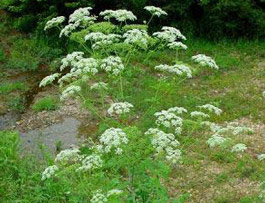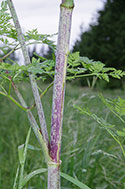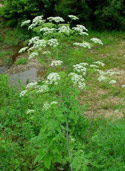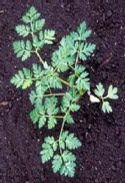Poison Hemlock
Conium maculatum • Class B |
||
| Family Name: | Apiaceae family (ay-pee-AY-see-ee) | |
| Common: | Carrot/celery family (formerly Umbelliferae) | |
| Genus: |
Conium (koh-NI-um) Meaning: From the ancient Greek koneion, the name given Poison Hemlock, referring to the plant and the poison derived from it |
|
| Species: |
maculatum (mak-yuh-LAY-tum) Meaning: Spotted |
|
| Description: |
Poison Hemlock is a very tall biennial plant that can grow up to 12 feet in height. It is a member of the parsnip or wild carrot family and its fernlike, finely divided leaves are similar to those of its parsley/carrot cousins. They grow in leaflets of 3 and have a mouse-like odor. The stem is strong, smooth, and has purples splotches on it. It has a long, white taproot, which may be branched. Flowers are white and grow in 4 to 8 inch umbrella shaped clusters. Each flower develops into a green, deeply ridged fruit that contains several seeds. One plant is capable of producing up to 38,000 seeds a season, which can remain viable in the soil for up to 6 years. |
|
| Why Is it a Noxious Weed? |
All parts of this plant are extremely toxic to animals and humans. The lower portions of the stem and root are particularly deadly. It can quickly invade large areas of pasture or vacant land. |
|
| Where Does it Grow? |
It is often found on poorly drained soils, particularly near streams, ditches, and other surface water. It also appears on roadsides, edges of cultivated fields, and waste areas. |
|
| Facts: |
Poison hemlock remains toxic for several years after being pulled. Bag up and dispose of all dead plant material to prevent accidental poisoning of wildlife or children. Do not compost this plant. Of the eight known alkaloids in poison hemlock, the principle toxins are the Piperidine alkaloids, coniine and coniceine. ALL PARTS OF THIS PLANT ARE POISONOUS. Dead canes remain toxic for up to 3 years. CONDITIONS THAT LEAD TO P.H. POISONINGS: Leaves are mistaken for the edible plants, parsley, carrot, Bur Chervil; seeds mistaken for Anise; root for Wild Carrot or parsnips; stems used for straws to blow through. It takes only 4 oz of P.H. vegetation to be fatal to adults, less for children; 16 oz is fatal for a horse or cow. Studies indicate that Poison Hemlock has allelopathic characteristics. Research shows that mowing Poison Hemlock during fruit development stage just after flowering or before seed set intensifies or concentrates the coniine and other forms of the alkaloids which then act as allelochemicals in the soil. |
|
| Control Options: |
|
|
| More Information: |
Download our Flyer or visit Washington State Noxious Weed Control Board Here. Photo by Leo Michels
|
|
| More Pictures: |
|





